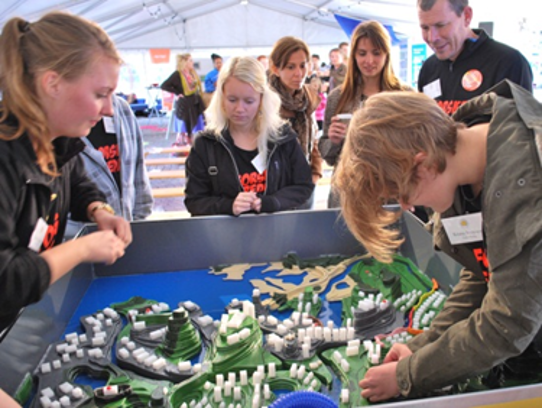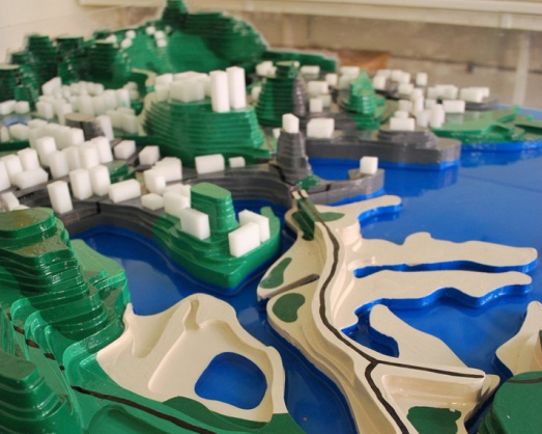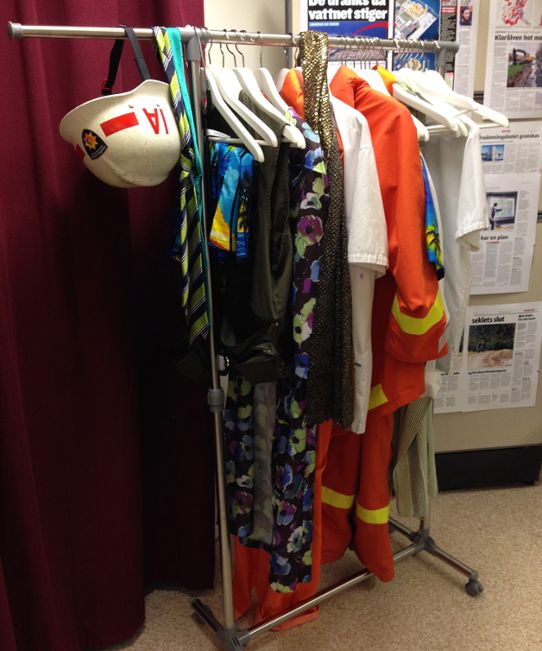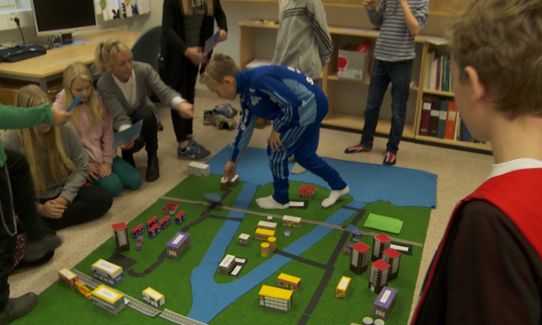At the Centre for Climate and Safety, there is the RiskLab (formerly Showroom), which is a demonstration room where research is made easily comprehensible and available through interactive communication and visualisation. Here, the visitors are given an opportunity to use all of their senses. The content has some permanent exercises, but is also flexible and can be adapted to the group of visitors.
An important part of the work is creating awareness around climate risks and the handling of them for various groups in society. Risk communication towards children and young people is a prioritised issue both in Sweden and internationally. RiskLab is often used as a part of the centre’s school activities directed at young people aged 12 to 17. The permanent points in RiskLab are presented here.

Floodville
In winter 2010/2011, the centre began thinking about the need for a physical way to incite interest in climate change and flood risks and society’s handling of them, which led to the development of the flood model Floodville.
Floodville is an easy-to-understand flood model developed at the Centre for Climate and Safety in collaboration with Värmlands Museum. The model represents a typical Swedish city close to water with a river that runs through the city and opens out into a lake or sea. Floodville is intended to stimulate learning about flood risks and society’s handling of them through a game.

The model was prepared as a part of the EU initiative “Researcher Friday” in 2011 and was used for the first time in autumn of the same year. The model that exists today is made of plastic and buildings are illustrated as small white houses. All functions critical to society are marked in red and equipped with sensors sensitive to water linked to a computer that senses when the function is flooded.
A Floodville scenario
Floodville can be used as a game where the participants are divided into teams or play individually. Early in the game, the participants get a warning that a storm is on the way and that the city will flood. The participants have a limited budget in the form of modelling and have the opportunity to carry out strategic protective measures like building flood banks around various objects in the city.
Water is released into the river and the water level rises. Ultimately the water level is so high that the water floods the city. Then the participants get to see if the flood banks held and what the consequences were from the banks before the water began to rise. The consequences of the flooding are worked out and presented in the form of a simple economic analysis on a screen next to the model. This way, the participants get an idea of the costs of the flooding.
The Floodville model has been much appreciated and had a positive breakthrough. In addition, there are thoughts about developing a new Floodville model that is easier to transport than today’s model.
Financing
The cost of developing Floodville was around SEK 300,000.
Role play
Another example of an activity in RiskLab is a role play around a flood situation.
What happens, who has responsibility and who does what? In the role play, the participants can dress up and take on roles that in some way are involved in a flood situation. This may be the rescue services, SOS alarm, the county administrative board, property owners, tourists, school children, pensioners or journalists. To get a real scenario started, the participants get a fixed script to act on.

The role play has the aim of letting the participants get an insight into and clarifying the sequence of events in a flood situation and which public actors are involved. The game was developed as a part of the university project the “Knowledge Street” in 2012 and is mainly addressed to a younger target audience. The game takes around 20 minutes to play.
Financing
The cost of developing the role play was around SEK 20,000.
The city builder game Riskköping
A third building block in RiskLab is the city builder game Riskköping (formerly called Vattenköping).
Planning a city based on new and existing development can be a challenge and there are often many different interests to take into consideration, which sets high requirements on the urban planning. In the game Riskköping, the participants get an understanding of how a society’s vulnerability to various risks relates to planning. At the same time, they get to be involved in the change process of a city by visually building and planning it and taking the residents’ wishes into account.
A green needle-loom carpet serves as the habitable land and blue cloth strips symbolise water, which in a typical game round is a river and a lake. Game pieces exist in the form of wood blocks that have been painted as holiday homes, high-rise buildings, villas, a school, pharmacy, hospital and other functions critical to society that are needed in a city. There are also roads and parking spaces in the form of paper.
Vattenköping (later Riskköping) was developed for the university project “Children’s University” in 2013. The game was developed according to experiences from the Floodville model which they wanted to supplement with a new activity. In 2016, the name of the game was changed to Riskköping to get a broader area of use that encompassed more risk perspectives.

Time to play
The script cards used can be reprinted to fit the particular risk perspective that the players are interested in. The students can also write the script cards themselves.
Depending on the number of participants that are in the game, the group is divided into teams. A game leader guides the course of the game and the participants get to hear a story about the city.
The game consists of three rounds: Plan and build, various events related to chosen risks and possible measures. The participants cooperate in the teams with the challenges and assignments they get from the game leader.
The city builder game has provided experiences that young people are interested in urban planning and like discussing important societal functions.
Financing
The cost of developing the game was around SEK 50,000.
More examples of climate adaptation
This is one of many examples of climate adaptation. There are more in the collection of ideas being built up by the Swedish National Knowledge Centre for Climate Change Adaptation at the Swedish Meteorological and Hydrological Institute (SMHI). The collection of examples has the aim of sharing experiences and providing ideas to everyone who works with climate adaptation. Examples describe concrete measures and challenges in several subject areas. They show how different actors have worked to adapt their activities to the climate changes that are already being noticed today and those that we cannot prevent in the future.